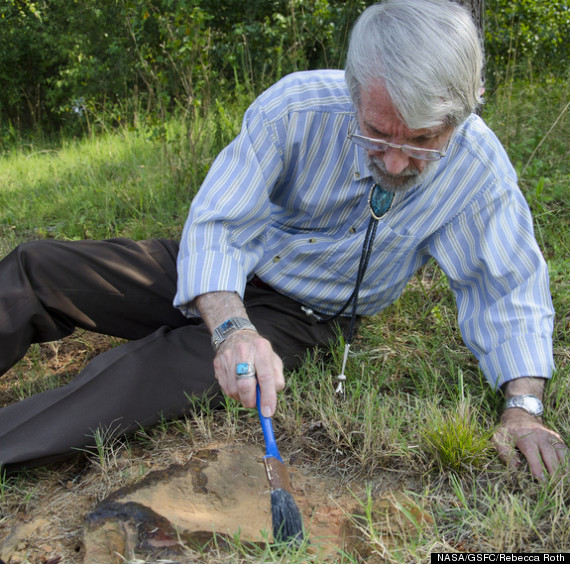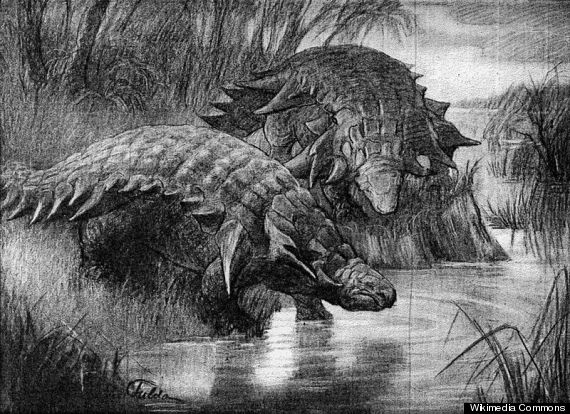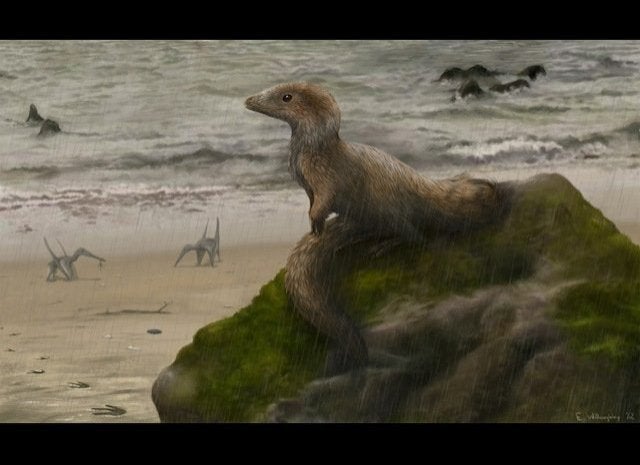By: Stephanie Pappas, LiveScience Senior Writer
Published: 08/21/2012 12:44 PM EDT on LiveScience
At NASA's Goddard Space Flight Center in Maryland, some of the most brilliant minds in the world work to build the spacecraft that humans use to explore their universe. But where space scientists now roam, dinosaurs used to call home, according to dino-hunter Ray Stanford.
Stanford has discovered the footprint of a lumbering, spiny dinosaur called a nodosaur in NASA's own backyard on the Goddard Space Flight Center campus. NASA officials aren't disclosing the precise location of the print, fearing that someone might damage or try to remove the fossilized track.
The dinner-plate-sized footprint bears the mark of four dino toes. It belongs to a nodosaur, a tank-like, armored beast studded with bony protuberances that roamed the area about 110 million years ago during the Cretaceous period, which lasted from about 125 million to 65 million years ago. Nodosaurs were plant-eaters, and this one appeared to be moving quickly across the Cretaceous mud, as its heel did not sink deeply into the ground. [See Images of the Ancient Dino-Print]
 The 12-inch-wide footprint belonged to an armored, tank-like plant-eater.
The 12-inch-wide footprint belonged to an armored, tank-like plant-eater.
Stanford, an amateur paleontologist who has had several papers published, confirmed his find with Johns Hopkins University dinosaur expert David Weishampel. On Aug. 17, Stanford shared the location of the find with Goddard officials and with Washington Post reporter Brian Vastag, who made the discovery public the same day.
Stanford also found several smaller dinosaur footprints in the area, likely from meat-eating theropods. He called the location "poetic."
"Space scientists may walk along here, and they're walking exactly where this big, bungling heavy-armored dinosaur walked, maybe 110 to 112-million years ago," Stanford told Goddard officials.

Artist's conception of Edmontonia, a genus of Nodosaur.
Maryland is no spring chicken when it comes to dinosaur fossils; in fact, the corridor between Washington, D.C., and Baltimore, Md., is known as "Dinosaur Alley," because so many of the beasts' fossils were discovered during iron mining in the 18th and 19th centuries, according to Weishampel. "Today, Maryland remains the only source of Early Cretaceous dinosaur fossils on the East Coast," he wrote in a 1996 article for Johns Hopkins University magazine.
Follow Stephanie Pappas on Twitter @sipappas or LiveScience @livescience. We're also on Facebook & Google+.
Copyright 2012 LiveScience, a TechMediaNetwork company. All rights reserved. This material may not be published, broadcast, rewritten or redistributed. ]]>
Support HuffPost
Our 2024 Coverage Needs You
Your Loyalty Means The World To Us
At HuffPost, we believe that everyone needs high-quality journalism, but we understand that not everyone can afford to pay for expensive news subscriptions. That is why we are committed to providing deeply reported, carefully fact-checked news that is freely accessible to everyone.
Whether you come to HuffPost for updates on the 2024 presidential race, hard-hitting investigations into critical issues facing our country today, or trending stories that make you laugh, we appreciate you. The truth is, news costs money to produce, and we are proud that we have never put our stories behind an expensive paywall.
Would you join us to help keep our stories free for all? Your contribution of as little as $2 will go a long way.
Can't afford to donate? Support HuffPost by creating a free account and log in while you read.
As Americans head to the polls in 2024, the very future of our country is at stake. At HuffPost, we believe that a free press is critical to creating well-informed voters. That's why our journalism is free for everyone, even though other newsrooms retreat behind expensive paywalls.
Our journalists will continue to cover the twists and turns during this historic presidential election. With your help, we'll bring you hard-hitting investigations, well-researched analysis and timely takes you can't find elsewhere. Reporting in this current political climate is a responsibility we do not take lightly, and we thank you for your support.
Contribute as little as $2 to keep our news free for all.
Can't afford to donate? Support HuffPost by creating a free account and log in while you read.
Dear HuffPost Reader
Thank you for your past contribution to HuffPost. We are sincerely grateful for readers like you who help us ensure that we can keep our journalism free for everyone.
The stakes are high this year, and our 2024 coverage could use continued support. Would you consider becoming a regular HuffPost contributor?
Dear HuffPost Reader
Thank you for your past contribution to HuffPost. We are sincerely grateful for readers like you who help us ensure that we can keep our journalism free for everyone.
The stakes are high this year, and our 2024 coverage could use continued support. If circumstances have changed since you last contributed, we hope you’ll consider contributing to HuffPost once more.
Already contributed? Log in to hide these messages.

 The 12-inch-wide footprint belonged to an armored, tank-like plant-eater.
The 12-inch-wide footprint belonged to an armored, tank-like plant-eater.
